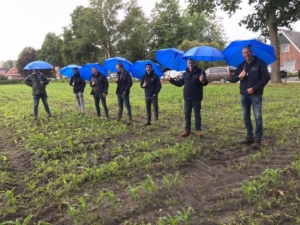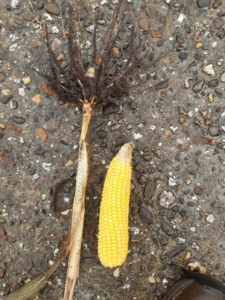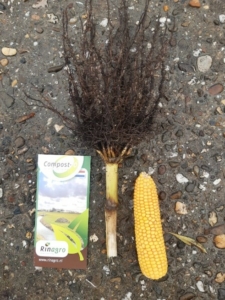Once upon a time there was a passionate colleague in South East Friesland on the road in early spring. Full of good courage and wonderful ideas and experiences he wanted to show the power of the products to those who still had some reservations about it.
In this way, a trial was conducted at 5 locations with 1 manure tank next to the plot where the remaining untreated manure came up. The manure was sucked up in the tank and the product went into the tank with it when sucked up. As a result, the advantages of the binding of the nitrogen in the manure and the mineralization of the organic part during the storage period were not achieved. Nevertheless, the product certainly has an effect in the short term to still administer, to prevent further losses and to stimulate soil life and plant growth in one breath.
Once the manure had been spread, it was the weather/nature’s turn to take the next steps. A somewhat miserable spring and summer caused a generally hampered start to plant growth. In June, the Dutch colleagues were on their way in this southeastern corner like a field day to observe the plots and the differences.
At first glance, it was already visible that one strip was much more consistent and tighter, with much less undulation and unevenness. The health of the plants was also a topic of conversation from the first plot, because the plants in the treated strip and the untreated rest were different in growth behavior, leaf formation, etc.
Summer followed and the nicer/better weather also steadily passed by in this northern province! Which also ensured that plant growth was significantly stimulated.
At the beginning of the dog days, the corn was in bloom and a significant difference in the height of treated and untreated corn was visible. This is due to the microbiome that is stimulated by the Compost-O® in combination with the release of phosphates, among other things, which stimulate the (root) growth of the plant. After all, a corn plant is a very strong rooter in the starting phase , if this lags behind in the beginning, this has a major influence on the further development of the plant and its fruit formation.
Then it came to the cob formation, the most exciting moment of the maize. A good maize plant can be as big, green and voluminous as anything, but without a good healthy full and ripe cob the maize is nothing…
Due to the wet spring and early summer, the disease pressure due to wet soil increases enormously, so there were poor plant starts and a high chance of problems. This was also reflected in the cob formation. In the cobs from the regular manure, the growth was somewhat retarded, so no full cobs and an early stage of fusarium (fungal disease) was visible. This disease picture was present on more than half of the plots of the trial. The treated strips, on the other hand, were visibly free of the disease picture, there was no fusarium to be found under the treated maize. In addition, the cobs were nicely full and then we were able to determine on one plot that there were about 16 rings per cob more and therefore plus or minus 100 grains per cob more.
During ripening, our colleague visited the plots again and picked, checked and weighed several cobs. More rings and cobs of course does not mean 1 on 1 more mass. For this, 7 to 10 cobs were randomly picked and weighed per plot. A difference was definitely visible in the structure of the cob and on the scale. Per cob, that was between 120-200 grams more mass in treated maize plants.
Out of curiosity, the necessary corn samples were sent for analysis. The results are still pending, but we are very satisfied with the tests and the results so far.
Would you like to know more about the application of Compost-O® or AgriMestMix® under your corn? And curious about the additional benefits when it does have a storage period to work in?!
Then feel free to contact us or contact your local Rinagro advisor.




